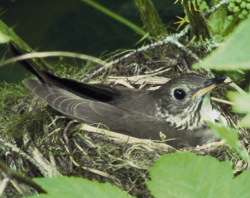Grey-cheeked thrush
| Grey-cheeked thrush | |
|---|---|
 | |
| Scientific classification | |
| Kingdom: | Animalia |
| Phylum: | Chordata |
| Class: | Aves |
| Order: | Passeriformes |
| Family: | Turdidae |
| Genus: | Catharus |
| Species: | C. minimus |
| Binomial name | |
| Catharus minimus (Lafresnaye, 1848) | |
| Synonyms | |
|
Hylocichla aliciae | |
The Grey-cheeked thrush (Catharus minimus) is a medium-sized thrush. This species is 15–17 cm in length, and has the white-dark-white underwing pattern characteristic of Catharus thrushes. It is a member of a close-knit group of migrant species together with the veery and Bicknell's thrush;[2] it forms a cryptic species pair with the latter. The grey-cheeked thrush is all but indistinguishable from Bicknell's thrush except by its slightly larger size and different song. The two were formerly considered conspecific.[3] Of all the American spotted thrushes, the Gray-cheeked has the most northern breeding range.[4]
Name
The specific name minimus is Latin for "smallest".[5]
Description
Adults are olive-brown on the upperparts. The underparts are white with gray on the flanks; the breast is greyish brown with darker spots. They have pink legs and a faint grey eye ring. They have gray cheeks.
They forage on the forest floor, mainly eating insects and berries.
This bird's song is a distant-sounding series of flute-like tones rising then falling in pitch. Like Bicknell's thrush, they are very secretive during the nesting season.
Range
Their breeding habitat is the boreal forests of spruce and tundra scrub of willow and alder[6] across northern Canada and Alaska and into Siberia.[7] They make a cup nest in a low location on a conifer or on the ground at the base of a shrub.
They migrate to northern South America, and are rarely seen as a vagrant in Europe. Its northerly breeding range and long-distance migration make it one of the more regular North American passerine migrants to cross the Atlantic.
References
- ↑ BirdLife International (2012). "Catharus minimus". IUCN Red List of Threatened Species. Version 2013.2. International Union for Conservation of Nature. Retrieved 26 November 2013.
- ↑ Winker, Kevin; Pruett, Christin L. (2006). "Seasonal Migration, Speciation, and Morphological Convergence in the Genus Catharus (Turdidae)" (PDF). The Auk. 123 (4): 1052. doi:10.1642/0004-8038(2006)123[1052:SMSAMC]2.0.CO;2. Archived from the original (PDF) on 2007-10-25.
- ↑ Ouellet, H (1993). "Bicknell's Thrush: Taxonomic Status and Distribution" (PDF). The Wilson Bulletin. 105 (4): 545–572.
- ↑ "Gray-cheeked Thrush". www.allaboutbirds.org. Retrieved 2017-06-04.
- ↑ Jobling, James A (2010). The Helm Dictionary of Scientific Bird Names. London: Christopher Helm. p. 256. ISBN 978-1-4081-2501-4.
- ↑ Kenn Kaufman. "Gray-cheeked Thrush". Guide to North American Birds. Audubon Society. Retrieved 10 August 2016.
- ↑ Brazil, Mark (2009) Birds of East Asia, A&C Black, ISBN 978-0-7136-7040-0, p. 400
External links
| Wikimedia Commons has media related to Catharus minimus. |
- Gray-cheeked Thrush – Catharus minimus – USGS Patuxent Bird Identification InfoCenter
- Gray-cheeked Thrush Species Account – Cornell Lab of Ornithology
